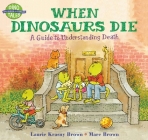I've just reread Nana Upstairs and Nana Downstairs by Tomie de Paola. It's so lovely: most of it is about visiting his grandmother and great-grandmother. I can see why it stayed in your memory all this time. When four year-old Tom sees that his grandmother ties her 94 year-old mother into a chair so she won't fall out, he asks to be tied into his chair too. There's a picture of them sitting side by side, tied in, both smiling. And there's a sequence of Tom watching both women fix their long white hair which brought back to me memories of Aunt Martha (your great-aunt) and her crown of white braids. After he learns Nana Upstairs has died, Tom runs to her room, only to find it empty.
Tommy began to cry.
"Won' t she ever come back?" he asked.
I wanted to move the discussion today to books that are written specifically to help children understand the death of someone they love. Our family is grieving for someone we love this week: Bob's mother, my children's grandma, died on Sunday. She cared about books, and with her husband raised an amazing reader, and it seems fitting to talk about mourning."No, dear," Mother said softly. "Except in your memory. She will come back in your memory whenever you think about her."
Nana is a book one can read as a story -- as you did as a child -- but which can be useful talking about someone who's died. After both Nana Upstairs, and years later Nana Downstairs die, Tom sees a shooting star. "Perhaps that was a kiss from Nana Upstairs," Mother tells the young Tom. The book gives a hint of something Bigger out there, without spelling it out.
 As with sex, Laurie Krasny Brown and Marc Brown have written a Very Thorough book on death:
As with sex, Laurie Krasny Brown and Marc Brown have written a Very Thorough book on death: When Dinosaurs Die: A Guide to Understanding Death. It defines alive and dead and gives lots of examples of ways to die (after long illness, sudden illness, accidents, as a baby, in war, "poverty, prejudice and drug abuse," and suicide). There's a lot about missing people, about overwhelming feelings, about funerals (illustrated with one for a pet). There are many different answers to "What Comes After Death?" It feels like it can be just too much information. But it does hit a lot of points.
 I think we've both established at some point that we're not particularly religious. I'm fond of the treatment of heaven in Judith Viorst's
I think we've both established at some point that we're not particularly religious. I'm fond of the treatment of heaven in Judith Viorst's The Tenth Good Thing About Barney. This one is about the death of a cat, and it's full of Viorst's wonderful kid-intensity. After Barney's backyard funeral, the narrator and his friend talk:
Annie said Barney was in heaven with lots of cats and angels,drinking cream and eating cans of tuna
The beauty of Barney is that the narrator makes a list of ten good things about the departed cat. It's an exercise people sometimes do with grieving kids.I said Barney was in the ground.
Heaven said Annie, heaven. So there! The ground, I told her, the ground. You don't know anything.
My father came in from the yard and took a cookie.Big-mouthed Annie said heaven again. I said ground.Tell her who's right, I asked Father. She doesn't know anything.
Maybe Barney's in heaven, my father began. Aha, said Annie, and stuck her tongue out at me.
And maybe, said my father, Barney isn't. What did I tell you, I said, and yanked Annie's braid.
Father made me let go.We don't know too much about heaven, he told Annie.We can't be absolutely sure that it's there.
But if it is there, said Annie in her absolutely sure voice,it's bound to have room for Barney and tuna and cream.She finished another cookie and went back home.
There are other books with groups of people (or animals standing in for people) reminiscing about special moments with the person who's no longer there. They're stories, presented as a kind of model for mourning. I'm curious if any of our readers have had satisfactory first-hand experience with a book for their kids to help process dying.
Love,
Deborah

No comments:
Post a Comment